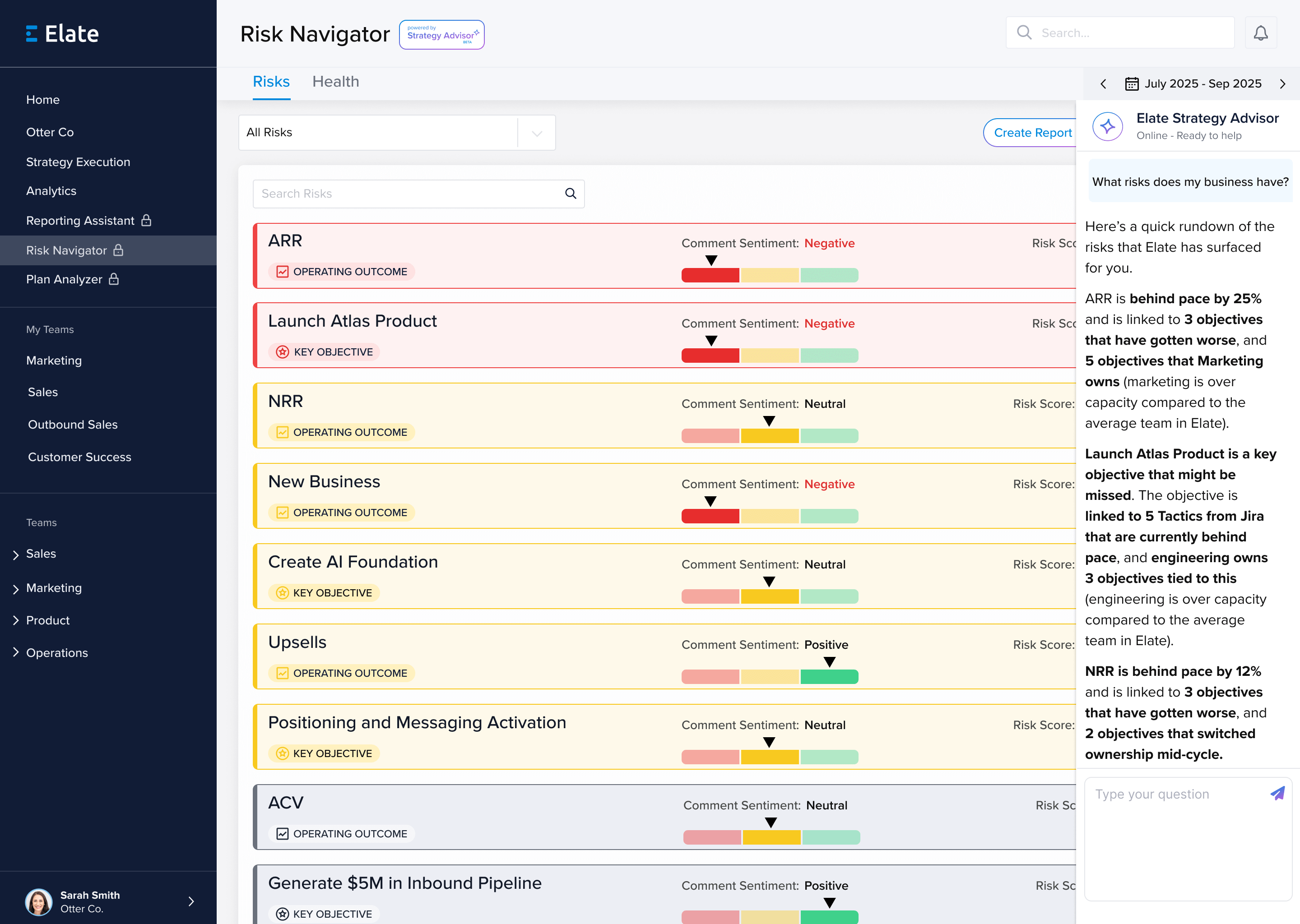The chaos and pace at a growth stage company can be overwhelming at times. With new employees being onboarded in waves, new revenue targets being set each quarter, and processes constantly changing, it can be hard to focus on the long-term direction with so much changing daily. However, without a clear plan of action, the growth that companies experience early on can quickly stagnate if the company isn’t properly setting goals and a strategic direction. And while it doesn’t ever seem like the right time to implement, an overarching strategic management plan can guide your company into the next phase of growth.
But, what is strategic management and how does it help? Well, strategic management can be defined as a style of management that aligns the vision for the company with the goals taken on by every employee at the organization. There are many factors that go into developing this plan, including resources, budget, and company culture.
When developing goals and planning out how to achieve them, many managers use strategic planning solutions to aid in the process. This often comes in the form of corporate planning software. Due to its flexibility, strategic planning software can be easily adapted to suit any type of organization regardless of size, revenue, or industry. Plus, with a variety of intuitive, dynamic options, you can create a real-time way to understand your company’s performance. This helps you keep the team on track no matter where everyone is located.
Regardless of how you choose to build your plan, finding the right strategy management solution will help increase the alignment and accountability throughout your organization. This leads to better plan adoption and buy-in so your team can reach your company’s goals faster and more efficiently.
Strategic Management
So to understand why strategic management was first created, let’s revisit the history and leaders that shaped the direction of businesses today. The concept of strategic management began in the 1950s and '60s. Before then, "strategy" was used to refer to military action and politics, not business decisions. Influential early contributors include Peter Drucker, Philip Selznick, Alfred Chandler, Igor Ansoff, and Bruce Henderson. This group defined and developed the strategic management concept, each building on the work of the one before. It is now used in some capacity by nearly every company.
The most common goal-setting advice is to set S.M.A.R.T. goals. This is a great starting place to achieving a goal, but might not take into account dependencies or underlying decisions tied to budgets, hiring, or working across teams. This is where strategic management comes in. While project management will help ensure the completion and success of a specific project, strategic planning creates a map of how everything is connected throughout your business. It specifically highlights how everything within the business is connected, outlining who in the organization needs to complete what and which resources they'll use to do so.
Consider the example of marathon training. You wouldn't sign up for a race and then not have a training plan. Just going out for a run of any distance or pace whenever you feel like it won't help you get a good finish time. Instead, you strategically manage your calendar to ensure the runs you're doing will help you reach your time goal on race day. You may use organizational planning software or a simple paper calendar, but you'll have a strategy.
For organizations, business execution software can help manage workflow among several teams to ensure everyone is working together to achieve the same goals. This makes it easy to keep everyone focused and updated on changes.
Strategic Management Concepts
There are many strategic management concepts to suit any type of organization. There's sure to be a method that works well for your team, but it can be difficult to choose one. Here are some of the most popular strategic management concepts.
SWOT Analysis: Based on work from Philip Selznick in 1957, Kenneth R. Andrews further developed a strategic management theory known as SWOT Analysis in 1963. This theory uses a 2 x 2 grid to assess a company's strengths and weaknesses against opportunities and threats in the industry. By putting all this information down on paper, you can more easily develop a strategy that uses your strengths to fight industry threats.
Experience Curve: Bruce Henderson founded Boston Consulting Group where he developed the theory of the experience curve and wrote about it in 1968. The hypothesis is that total cost per unit declines by 15-25% every time production doubles. Essentially, the more experienced you are, the less it costs to run your business. These costs may decline due to the proficiency of your employees, automating tasks, and technological advancements.
Portfolio Growth-Share Matrix: In 1970, the Boston Consulting Group also developed the strategic management theory of a corporation as a portfolio of business units. These units can then be plotted on a graph based on market share and industry growth rate. Measuring and plotting these units helps managers clearly see where to invest more resources and where to divest. General Electric followed this up with the G.E. multi-factorial model.
Objectives and Key Results: First made popular by Google, Objectives and Key Results (OKRs) have been around since Andy Grove first introduced them at Intel. While OKRs aren’t a traditional strategic management concept, they have become a popular method for how growth stage companies go about setting goals to drive outcomes. Centered around the idea of setting a clearly defined objective that has 3-5 key results that can be measured, OKRs help simplify the process of planning for growth stage companies.
There are several other strategic management concepts if none of the above feel like they apply to your company. However, one important note is that any framework should also take into account your business. Make sure you understand the rhythm, cadence and structure that will work for your team.
Example Of Strategic Management
There are three main phases to a successful strategic management plan: formulation, implementation, and evaluation. Let's go through an example of strategic management in action to see how they all work together.
Formulation: When developing a plan, you must figure out what your ultimate goal is. Be sure to use the S.M.A.R.T. goals framework to really narrow down what you want. These goals may be taken from leadership or upper management. Common goals may include revenue, brand awareness, customer success, culture , and more. If you've chosen to go the product and engineering route, your software strategy examples will come in handy here. After clearly defining your company's goal, figure out who in the organization needs to do what and how they should do it in order to reach that goal.
Implementation: During this phase, you share your goals and strategy with all employees. Traditionally, this has been done by sharing a strategic management PDF. However, with solutions like Elate, this process can be streamlined for efficiency and effectiveness by leveraging the power of integrations and automation to connect your plan throughout the company. It's also important to get buy-in from every employee, so you can see results and have insight into what’s going on across the business. If an individual or department is not on-board with your plan, they won't try very hard to implement the changes you're requesting and can slow down your progress.
Evaluation: Once you've reached your goal, take a look back at your strategy to see what worked well and what didn't. Your Strategic Planning solution should help by providing a dashboard to help evaluate outcomes across every team easily. This will help you more effectively engage in your next quarter or annual planning session. However, don’t wait until the end of the quarter or year to start evaluating performance. Before you reach your goal, you should always be evaluating how things are going so you can make adjustments proactively. Your strategic management software can be a great help in analyzing the data and surfacing this information.
Cascade Strategy
When building a strategic plan, it's important to cascade this strategy throughout the entire organization. This helps align every department with your strategy so everyone is doing their part to help achieve a common goal.
To cascade strategy effectively, you must divide the overall goals throughout the various departments and understand how they’re connected. For example, if your goal involves increasing revenue, you need to know how Marketing, Engineering, Product, and even Finance can help with this. Each department will then have their own tasks to complete, but all will be working to increase revenue.
When it comes to strategic execution management, you need a coordinated effort to keep track of who should be doing what and how well they're performing. One of the easiest ways to manage this is to have regular meetings where department heads report on their progress. Designate one person to take notes and compare progress from the last meeting. Depending on your goals, you may choose to have these meetings once per week, month, or quarter.
Of course, not all of us are organized enough to keep track of every little detail. Thankfully, there are many strategic plan tracking tools that allow you to roll out your strategy to the entire organization and allow for strategic execution management. While project management apps may feel like a quick fix, it’s important to leverage software that scales with your company. Organizational planning software can be a way to ensure spreadsheets and project management solutions don’t cause hurdles for your company as you continue to grow.
Strategy Execution Management Software
To ensure the success of your plan, you need to use the right strategic planning tools. Having the wrong tools can cause confusion or misalignment among your teams, which doesn't help you reach your goals. Having one go-to source for all communications, tasks, and progress updates helps streamline the process and makes it easier for everyone to participate and stay informed.
Meet Elate.
Elate is the first Strategic Planning software built to help SaaS companies communicate their vision, create alignment, and track performance all in one place.
Elate is a strategy execution software that helps you clearly align your organization's goals with your various teams departments. With Elate, you can communicate your vision, create alignment, and track performance all in one place. This allows your team to cascade strategy, easily communicate across departments, and make the most of your leadership meetings.
The all-in-one dashboard integrates with all your favorite tools, such as Google Analytics, Salesforce, Quickbooks, HubSpot, Slack, and more. With one convenient dashboard, you have access to all your information with real-time insights. And you don't have to wait for someone to update you. When everyone works in the platform together, you can see how performance across different goals are tied together and impacting the direction of your business. This helps you easily identify areas that need work before it's too late.
You also get access to a strategic planning expert. With a one-on-one call we can help you implement OKRs, set up your objectives, track important KPIs, and transfer information from an outdated spreadsheet to our automated dashboard.
Elate is the leading strategy execution management software to help businesses. If you’re interested in learning more, contact us today for a demo!











